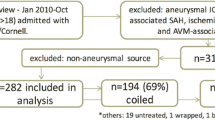Summary
A retrospective analysis of 183 consecutive patients operated on for ruptured cerebral aneurysms and surviving at least one year revealed appearance of postoperative epilepsy in 14 cases (8 per cent) on an average of 10 months (range 0–23 months) after the operation. Factors associated with the development of secondary epilepsy were localization of the aneurysm on the middle cerebral artery, temporary clipping intraoperatively, wrapping technique to treat the aneurysm, and vasospasm seen on the postoperative control angiogram. Intraoperative and/or postoperative ischaemia seems to be the crucial phenomenon favouring the development of epilepsy. Identification of the risk factors may help to focus the anti-epileptic prophylaxis in cases prone to develop seizures.
Similar content being viewed by others
References
Auer LM, Brandt L, Ebeling U,et al (1986) Nimodipine and early aneurysm operation in good condition SAH patients. Acta Neurochir (Wien) 82: 7–13
Brandt L, Säveland H, Ljunggren B,et al (1988) Control of epilepsy partialis continuans with intravenous nimodipine. J Neurosurg 69: 949–950
Deutschman CS, Haines SJ (1985) Anticonvulsant prophylaxis in neurological surgery. J Neurol Neurosurg Psychiatry 17: 510–515
Dichter M (1989) Cellular mechanism of epilepsy and potential new treatment strategies. Epilepsia 30: 3–12
Gelmers HJ, Gorter K, de Weerdt CJ,et al (1988) A controlled trial of nimidipine in acute ischemic stroke. N Engl J Med 318: 203–207
Glaser GH (1987) Natural history of temporal lobe-limbic epilepsy. In: Engel J Jr (ed) Surgical treatment of epilepsies. Raven Press, New York, pp 13–30
Grotenhuis JA, Bettag W (1986) Prevention of symptomatic vasospasm after SAH by constant venous infusion of nimodipine. Neurol Res 9: 243–249
Heikkinen ER, Rönty H, Tolonen U,et al (1990) Development of posttraumatic epilepsy. Stereotactic and functional neurosurg, in press
Hillman J, v Essen C, Leszniewski W (1988) Results of treatment for cerebral saccular aneurysms in a small neurosurgical unit-evaluation of early operation and nimodipine treatment. Acta Neurochir (Wien) 94: 28–31
Keränen T, Tapaninaho A, Hernesniemi J,et al (1985) Late epilepsy after aneurysm operation. J Neurosurg 17: 897–900
Larsson C (1989) Verbal memory function after subarachnoid haemorrhage determined by the localization of the ruptured aneurysm. Br J Neurosurg 3: 549–559
Lee S-T, Lui T-N, Chang C-N,et al (1989) Prophylactic anticonvulsant for prevention of immediate and early postcraniotomy seizures. Surg Neurol 31: 361–364
Mee E, Dorrence D, Lowe D,et al (1989) Controlled study of nimodipine in aneurysm patients treated early after subarachnoid hemorrhage. J Neurosurg 22: 484–491
Sbeih I, Tamas LB, Laoire SA,et al (1986) Epilepsy after operation for aneurysms. J Neurosurg 19: 784–787
Author information
Authors and Affiliations
Rights and permissions
About this article
Cite this article
Ukkola, V., Heikkinen, E.R. Epilepsy after operative treatment of ruptured cerebral aneurysms. Acta neurochir 106, 115–118 (1990). https://doi.org/10.1007/BF01809452
Issue Date:
DOI: https://doi.org/10.1007/BF01809452




